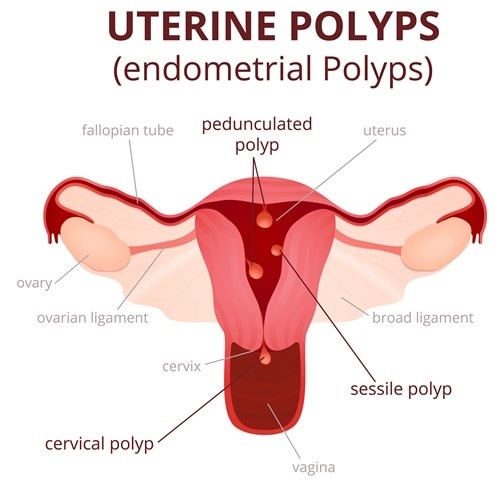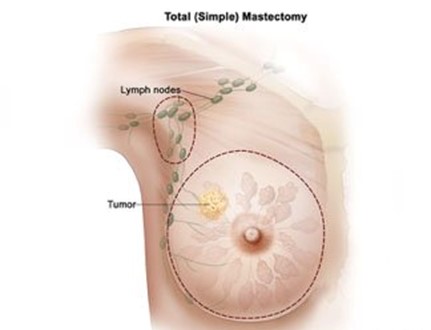A nurse is assessing a female client and suspects that the client may have endometrial polyps based on which clinical manifestation?
Bleeding between menses
Bleeding after intercourse
Metrorrhagia
Vaginal discharge
The Correct Answer is C
Choice A: Bleeding between menses is not the correct answer because it is not a specific clinical manifestation of endometrial polyps. Bleeding between menses is a condition that causes spotting or bleeding at any time other than during the normal menstrual period. It can be caused by various factors such as hormonal imbalance, infection, or pregnancy. It can also occur in some women with endometrial polyps, but it is not a definitive sign of them.
Choice B: Bleeding after intercourse is not the correct answer because it is not a specific clinical manifestation of endometrial polyps. Bleeding after intercourse is a condition that causes bleeding from the vagina or cervix after sexual activity. It can be caused by various factors such as trauma, infection, or cancer. It can also occur in some women with endometrial polyps, but it is not a definitive sign of them.
Choice C: Metrorrhagia is the correct answer because it is a specific clinical manifestation of endometrial polyps. Metrorrhagia is a condition that causes irregular or excessive bleeding from the uterus that is unrelated to the menstrual cycle. It can be caused by various factors such as polyps, fibroids, or cancer. It is a common symptom of endometrial polyps, which are benign growths of the endometrium (the lining of the uterus) that can protrude into the uterine cavity and cause bleeding.
Choice D: Vaginal discharge is not the correct answer because it is not a specific clinical manifestation of endometrial polyps. Vaginal discharge is a fluid that comes out of the vagina and varies in color, consistency, and odor depending on the phase of the menstrual cycle, sexual activity, or health status. It can be caused by various factors such as normal secretions, infection, or inflammation. It is not a common symptom of endometrial polyps, which do not usually affect the vaginal flora or pH.

Nursing Test Bank
Naxlex Comprehensive Predictor Exams
Related Questions
Correct Answer is A
Explanation
Choice A: Do not apply heat to the area of irradiation. This instruction is correct and should be included in the teaching. Applying heat to the area of irradiation can increase inflammation, pain, or burning sensation on the skin. The client should avoid heat sources such as hot water, heating pads, or sun exposure in the area of irradiation.
Choice B: Use an antibiotic ointment to treat skin breakdown. This instruction is not correct and should not be included in the teaching. Using an antibiotic ointment to treat skin breakdown can cause allergic reactions, infection, or interference with radiation therapy. The client should consult with her provider before using any topical products in the area of irradiation.
Choice C: Lubricate the skin with hypoallergenic lotion. This instruction is not correct and should not be included in the teaching. Lubricating the skin with hypoallergenic lotion can cause irritation, infection, or interference with radiation therapy. The client should avoid applying any lotions, creams, or oils on the area of irradiation unless prescribed by her provider.
Choice D: Do not wash the area of irradiation. This instruction is not correct and should not be included in the teaching. Washing the area of irradiation can help prevent infection, remove dead skin cells, and reduce odor. The client should wash the area of irradiation gently with mild soap and water, pat it dry, and avoid rubbing or scrubbing.

Correct Answer is A
Explanation
Choice A: "You seem scared to talk to your parents." This response is appropriate because it reflects the client's feelings and shows empathy and respect. It also opens the door for further communication and support from the nurse.
Choice B: "If you want me to, I can tell your parents for you." This response is not appropriate because it does not respect the client's autonomy and confidentiality. It also may make the client feel more anxious or helpless and may damage the trust between the client and the nurse.
Choice C: "Your parents will have to be told why you are being admitted." This response is not appropriate because it does not address the client's feelings or concerns. It also may sound harsh or threatening to the client, who may fear the consequences of telling her parents.
Choice D: "Give your parents a chance; they'll understand." This response is not appropriate because it does not acknowledge the client's feelings or concerns. It also may sound unrealistic or insensitive to the client, who may have valid reasons to doubt her parents' reaction or acceptance.
Whether you are a student looking to ace your exams or a practicing nurse seeking to enhance your expertise , our nursing education contents will empower you with the confidence and competence to make a difference in the lives of patients and become a respected leader in the healthcare field.
Visit Naxlex, invest in your future and unlock endless possibilities with our unparalleled nursing education contents today
Report Wrong Answer on the Current Question
Do you disagree with the answer? If yes, what is your expected answer? Explain.
Kindly be descriptive with the issue you are facing.
